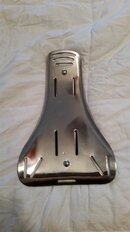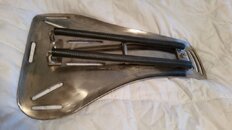I'm encouraging Eric to make an doubles adapter for his new plate. The latest design will be a lot easier. A quick & dirty version would be of a piece of metal that spans the bands with an extra set of holes for the 5/16" carriage bolts -- think metal strip with 4 holes. Two for the band studs and two for the plate. Longer carriage bolts and some spacers should do it.
I believe I am visualizing exactly what you're talking about. The question is, would it hold the tanks right up against the plate, just like with a "normal" plate? And, would it do so without having to adjust the bolts that go through the doubles bands?
In my mind's eye, it seems like the tanks would be just a little off your back, where they are right against your back with a standard plate.
Hmmm.... as I think about it more, maybe the worst case is the tanks would be further from your back only by the thickness of the plate itself - so 1/8". And, depending on the standard plate you're comparing it to, maybe the tanks would not be any further off your back.
Okay! I agree! Eric should make a really nice doubles adapter for the Freedom plate.








